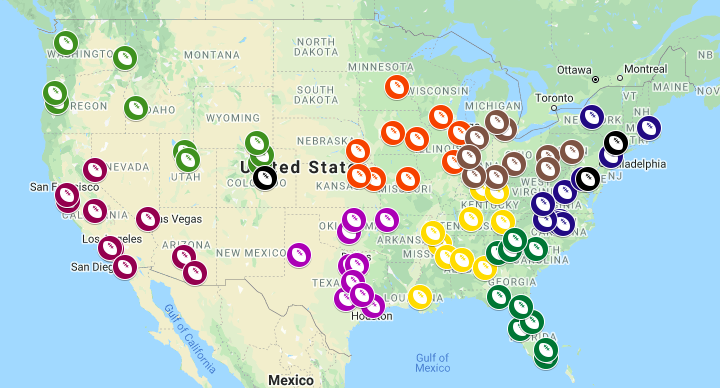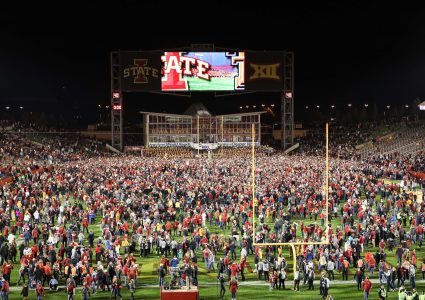The idea to re-invent college football in a system based purely on geography rather than overinflated conferences built around television dollars and eyeballs is nothing new. People have been doing it for as long as the Big Ten has spanned from Lincoln to Piscataway and the Big 12’s stretched from Manhattan to Morgantown.
But, in a time of great uncertainty surrounding the future of college football, I figured I would take a stab at what the sport could look like in a world in which geography reigns supreme.
First of all, I want to say that all of this is completely hypothetical and in no way am I suggesting that this could become a reality. Do I think that it would be cool? Hell yes, I do, but that’s all it is — at least right now. A cool hypothetical.
Now, some rules that will be instituted in this scenario and a basic barebones synopsis of the overarching setup.
1 – Prior to ever forming the new divisions of what I have decided to call the Intercollegiate Football Association, there will be a commissioner named to lead the sport. For today, I will humbly accept the position as IFA commissioner, but the role would realistically be held by a former coach, player or college administrator.
2 – This commissioner will not answer to any particular group, i.e. a professional league commissioner working for the owners. He will always be tasked with doing what is right for college football and not what is right for any particular entity.
Here’s the format for how this will look.
1 – I have selected 83 college football programs to join the IFA. Those 83 teams have been broken into eight 10-team conferences based on geography. By geography I mean that no schools who share the same state will be broken up and they will largely play against schools from states that border theirs.
Now, I’m sure you’re wondering how I landed on 83 teams then in the next sentence said there will be eight 10-team conferences. Either I’m really bad at math or there is more to the plan.
The reality is both of those things are true, but the former has nothing to do with this right now, which brings us to point No. 2.
2 – Each of the three armed forces academies will be in the IFA, but as independents. Their schedules will be composed by one game against each other and then 10 games against one member of each league.
The school the academy plays each year will be on a rolling basis in alphabetical order to where each team will play all three academies in a 10-year span and each individual academy once every 10 years. I don’t know how to explain this better so I’ll just show you on a chart.
| Illinois | Air Force | Army | Navy | |||||||
| Iowa | Army | Navy | Air Force | |||||||
| Iowa State | Navy | Air Force | Army | |||||||
| Kansas | Air Force | Army | Navy | |||||||
| Kansas State | Army | Navy | Air Force | |||||||
| Minnesota | Navy | Air Force | Army | |||||||
| Missouri | Air Force | Army | Navy | |||||||
| Nebraska | Army | Navy | Air Force | |||||||
| Northwestern | Navy | Air Force | Army | |||||||
| Wisconsin | Air Force | Army | Navy |
So, as you can see, each school will have a game against one of the academies once every three to four years. That game will be locked into each school’s schedule and will take up one non-conference contest.
3 – On that note, schools will play 12 game schedules with nine conference games and three non-conference games. Like I said, every three to four years one of those non-conference games will be occupied by an armed forces academy.
The three (or two) non-conference games will be determined by the IFA office prior to each season in the interest of competitive balance, creating the best match-ups, maintaining traditional rivalries otherwise broken by the creation of the geographical divisions (i.e. Notre Dame and USC) and even celebrating the anniversaries of classic games (i.e. 50th anniversary of Nebraska/Oklahoma “Game of the Century in 2021 or 40th anniversary of Doug Flutie’s Hail Mary against Miami (FL) in 2024).
Basically, the schedule will be created in the interest of getting the absolute best match-ups during non-conference play. Games like mentioned above would be used as the national headliners in the traditional college football television slate as guaranteed high-profile contests.
4 – Deciding a national champion will be done by the eight-division winners (determined in a round-robin format, conference championship games are dead) and eight at-large teams playing in a 16-team playoff with first-round games played in on-campus stadiums, second-round games played in an NFL stadium inside the higher seed’s home region (i.e. Cowboy Stadium or Reliant Stadium for Texas, Arrowhead, US Bank or Soldier Field for Iowa State (a guy can dream)), semifinal match-ups rotated through the traditional New Year’s Six game sites and the championship at a pre-determined location.
In the event an armed forces academy goes undefeated, they will receive an automatic bid. Otherwise, they will be held to the same at-large standards as every other program.
The at-large bids will be determined by a committee made up of former coaches and players led by the IFA commissioner.
Alright, with all of that out of the way, here is how the divisions would be composed, starting with the one near and dearest to those of us in Iowa, the Central Division.
Central – Illinois, Iowa, Iowa State, Kansas, Kansas State, Minnesota, Missouri, Nebraska, Northwestern and Wisconsin
Think about a rivalry weekend after Thanksgiving with matchups like this — Iowa State/Iowa, Illinois/Northwestern, Minnesota/Wisconsin, Kansas/Missouri and Nebraska/Kansas State. Annually.
That would certainly make for some interesting Thanksgiving dinner conversation around the Midwest.
Rust Belt – Cincinnati, Indiana, Michigan, Michigan State, Notre Dame, Ohio State, Penn State, Pittsburgh, Purdue, West Virginia
Cincinnati vs. Ohio State. The return of the Backyard Brawl between Pitt and West Virginia. Michigan, Michigan State, Ohio State and Penn State vs. Notre Dame every year. This would be jam packed with fun.
Northeast – Boston College, Duke, Maryland, North Carolina, North Carolina State, Rutgers, Syracuse, Virginia, Virginia Tech, Wake Forest
The reality of this entire exercise is that a few of these divisions were going to end up being, well, to put it simply, bad, but none of the others are as bad as this. I tried so freaking hard to figure out a way to keep Rutgers out of this thing (you’ll notice I did keep UConn out), but it just didn’t make sense to leave out a current Power 5 team the more I thought about it. Alas, I think we can all agree that this division would most likely give us a team annually destined to be destroyed by the first or second seed in the playoffs.
Southeast – Central Florida, Clemson, Florida, Florida Atlantic, Florida State, Georgia, Georgia Tech, Miami (FL), South Carolina, South Florida
All this division makes me think about is how many ridiculous crimes would likely be committed by Florida men as the result of these games. It would just be an absolute Florida brawl, plus Central Florida would finally get a chance to earn the national title they claim from 2017 and we’d be guaranteed an annual match-up between Georgia and Clemson.
Quick note: I know the Florida Atlantic inclusion looks weird, but, c’mon, would we rather have the Owls or freaking UConn?
Deep South – Alabama, Auburn, Kentucky, Louisville, LSU, Memphis, Mississippi State, Ole Miss, Tennessee, Vanderbilt
Imagining the party LSU fans would have on Beale Street gives me a hangover.
Southwest – Arkansas, Baylor, Houston, Oklahoma, Oklahoma State, SMU, TCU, Texas, Texas Tech, Texas A&M
Basically just the O.G. Southwest Conference only without Rice (sorry, only room for one Owls in the IFA) and with the Oklahoma schools. Finally, Texas and Texas A&M can end their high-horse pissing match and bring their rivalry back.
West Coast – Arizona, Arizona State, Cal, Fresno State, Nevada, San Diego State, Stanford, UCLA, UNLV, USC
I had a tough time with this one for a couple different reasons. One, I felt like the Arizona schools could have fit better somewhere else, but it just kind of had to work this way. Secondly, UNLV has no business being here, and Fresno might not either, but the alternatives are exponentially worse. I considered Hawaii, but in the end the Rebels got the nod.
Northwest – BYU, Boise State, Colorado, Colorado State, Oregon, Oregon State, Utah, Washington, Washington State, Wyoming
BYU and Boise State finally get their spots at the big boy table. Wyoming gets to come along for some reason because there’s hardly any major college football programs in the Pacific Northwest. This ends up as the division with the longest distance between two programs (Washington and Colorado – roughly 1,200 miles).
Like I said at the beginning of this, at the end of the day, this is all completely hypothetical and I did it for my own enjoyment.
The more I think about that Thanksgiving weekend in the Central, though, the more fun it sounds.





